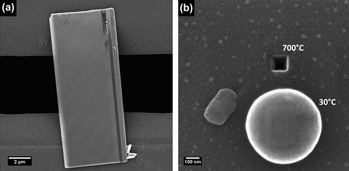Crossref Citations
This article has been cited by the following publications. This list is generated based on data provided by
Crossref.
Alkemade, P. F. A.
and
Miro, H.
2014.
Focused helium-ion-beam-induced deposition.
Applied Physics A,
Vol. 117,
Issue. 4,
p.
1727.
Timilsina, R
Tan, S
Livengood, R
and
Rack, P D
2014.
Monte Carlo simulations of nanoscale focused neon ion beam sputtering of copper: elucidating resolution limits and sub-surface damage.
Nanotechnology,
Vol. 25,
Issue. 48,
p.
485704.
Campo, Eva M.
Larios, Eduardo
Huynh, Chuong
and
Ananth, Mohan
2015.
Helium ion microscopy of electrospun CNT–polymer composites.
Journal of Materials Research,
Vol. 30,
Issue. 1,
p.
130.
Shorubalko, Ivan
Pillatsch, Lex
and
Utke, Ivo
2016.
Helium Ion Microscopy.
p.
355.
Tan, Shida
and
Livengood, Rick
2016.
Helium Ion Microscopy.
p.
471.
Jesse, Stephen
Borisevich, Albina Y.
Fowlkes, Jason D.
Lupini, Andrew R.
Rack, Philip D.
Unocic, Raymond R.
Sumpter, Bobby G.
Kalinin, Sergei V.
Belianinov, Alex
and
Ovchinnikova, Olga S.
2016.
Directing Matter: Toward Atomic-Scale 3D Nanofabrication.
ACS Nano,
Vol. 10,
Issue. 6,
p.
5600.
Stanford, Michael G.
Lewis, Brett B.
Mahady, Kyle
Fowlkes, Jason D.
and
Rack, Philip D.
2017.
Review Article: Advanced nanoscale patterning and material synthesis with gas field helium and neon ion beams.
Journal of Vacuum Science & Technology B, Nanotechnology and Microelectronics: Materials, Processing, Measurement, and Phenomena,
Vol. 35,
Issue. 3,
Li, Rongrong
Zhu, Rui
Chen, Shulin
He, Chao
Li, Mingqiang
Zhang, Jingmin
Gao, Peng
Liao, Zhimin
and
Xu, Jun
2019.
Study of damage generation induced by focused helium ion beam in silicon.
Journal of Vacuum Science & Technology B, Nanotechnology and Microelectronics: Materials, Processing, Measurement, and Phenomena,
Vol. 37,
Issue. 3,
Fang, Fengzhou
Zhang, Nan
Guo, Dongming
Ehmann, Kornel
Cheung, Benny
Liu, Kui
and
Yamamura, Kazuya
2019.
Towards atomic and close-to-atomic scale manufacturing.
International Journal of Extreme Manufacturing,
Vol. 1,
Issue. 1,
p.
012001.
Shao, Tianyang
Chen, Qianhuang
Xing, Yan
Lin, Xiaohui
Fang, Chen
and
Chai, Qing
2020.
An Experiment Based Damage Profile Function for Focused Helium Ion Beam Process in Fabrication of Micro/Nano Structures.
p.
905.
Allen, Frances I
2021.
A review of defect engineering, ion implantation, and nanofabrication using the helium ion microscope.
Beilstein Journal of Nanotechnology,
Vol. 12,
Issue. ,
p.
633.
Busch, Richard
Tielemann, Christopher
Reinsch, Stefan
Müller, Ralf
Patzig, Christian
Krause, Michael
and
Höche, Thomas
2021.
Sample preparation for analytical scanning electron microscopy using initial notch sectioning.
Micron,
Vol. 150,
Issue. ,
p.
103090.



